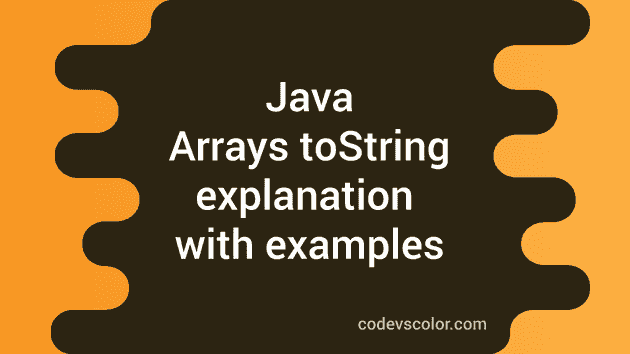Java Arrays toString method:
Arrays class of Java provides a method called toString to convert the content of an array to a string. This method can be used to convert an array to string easily.
In this post, we will learn how to use toString method with examples.
Definition of Arrays.toString:
The Arrays.toString method is defined as like below:
public static String toString(short[] arr)
public static String toString(byte[] arr)
public static String toString(long[] arr)
public static String toString(int[] arr)
public static String toString(char[] arr)
public static String toString(boolean[] arr)
public static String toString(float[] arr)
public static String toString(double[] arr)
public static String toString(object[] arr)Each of these methods returns the string representation of the contents of the array. The string value will include all elements of the array separated each element by a comma followed by a space and enclosed in a square bracket, []. Each elements are converted to String.
Here, arr is the array to convert to a string and it returns the string representation of the array.
If the array is null, it returns null.
Let me show you how toString works with different types of arrays:
Example with a short array:
Let’s check it with a short array:
import java.util.Arrays;
class Main {
public static void main(String[] args) {
short[] shortArray = {1, 2, 3, 100, 1000};
System.out.println(Arrays.toString(shortArray));
}
}It will print:
[1, 2, 3, 100, 1000]Example with a byte array:
Let’s use toString with a byte array:
import java.util.Arrays;
class Main {
public static void main(String[] args) {
byte[] byteArray = {1, 2, 3, 100, 101};
System.out.println(Arrays.toString(byteArray));
}
}It will print:
[1, 2, 3, 100, 101]Example with a long array:
Arrays.toString with a long array:
import java.util.Arrays;
class Main {
public static void main(String[] args) {
long[] longArray = {10123L, 11222211L, 101011010L};
System.out.println(Arrays.toString(longArray));
}
}It will print:
[10123, 11222211, 101011010]Example with an integer array:
Example of Arrays.toString with an integer array:
import java.util.Arrays;
class Main {
public static void main(String[] args) {
int[] intArray = {1013, 119898, 192829, -999918181};
System.out.println(Arrays.toString(intArray));
}
}It will print:
[1013, 119898, 192829, -999918181]Example with a character array:
Example of Arrays.toString with a character array:
import java.util.Arrays;
class Main {
public static void main(String[] args) {
char[] charArray = {'a', 'e', 'i', 'o', 'u'};
System.out.println(Arrays.toString(charArray));
}
}It will print:
[a, e, i, o, u]Example with a boolean array:
Example of Arrays.toString with a boolean array:
import java.util.Arrays;
class Main {
public static void main(String[] args) {
boolean[] boolArray = {true, false, false, true, true};
System.out.println(Arrays.toString(boolArray));
}
}It will print:
[true, false, false, true, true]Example with a float array:
Example of Arrays.toString with a float array:
import java.util.Arrays;
class Main {
public static void main(String[] args) {
float[] floatArray = {12.23f, 12f, -2.34f};
System.out.println(Arrays.toString(floatArray));
}
}It will print:
[12.23, 12.0, -2.34]Example with a double array:
Example of Arrays.toString with a double array:
import java.util.Arrays;
class Main {
public static void main(String[] args) {
double[] doubleArray = {12.23, -34.45, 23.3455};
System.out.println(Arrays.toString(doubleArray));
}
}It will print:
[12.23, -34.45, 23.3455]Example with object array:
Let’s try it with an object array:
import java.util.Arrays;
class Student {
String name;
int age;
Student(String name, int age) {
this.name = name;
this.age = age;
}
}
class Main {
public static void main(String[] args) {
Student[] students = {new Student("Alex", 12), new Student("Bob", 11)};
System.out.println(Arrays.toString(students));
}
}In this example, Student class is used to hold the name and age of a student. We created one array students with two objects of Student.
We are using Arrays.toString to print the content of this array.
It will print one output as like below:
[Student@4554617c, Student@74a14482]As you can see here, the output is not meaningful. We can override the toString method to make it print the data:
import java.util.Arrays;
class Student {
String name;
int age;
Student(String name, int age) {
this.name = name;
this.age = age;
}
@Override
public String toString() {
return "Student{" +
"name='" + name + '\'' +
", age=" + age +
'}';
}
}
class Main {
public static void main(String[] args) {
Student[] students = {new Student("Alex", 12), new Student("Bob", 11)};
System.out.println(Arrays.toString(students));
}
}It will print:
[Student{name='Alex', age=12}, Student{name='Bob', age=11}]You can change the return statement of toString to anything you want.
You might also like:
- 3 different Java programs to print Pascal’s triangle for a given height
- Java program to check if a number is a spy number or not
- Java program to check if a number is a duck number or not
- Java program to check if a number is evil number or not
- Java Math.random() method example to create random numbers
- Java program to check if a number is a spy number or not
- 4 different Java program to check if a number is a sunny number or not
- Java Arrays binarySearch method explanation with example
- java.util.Arrays.deepEquals method explanation with examples

